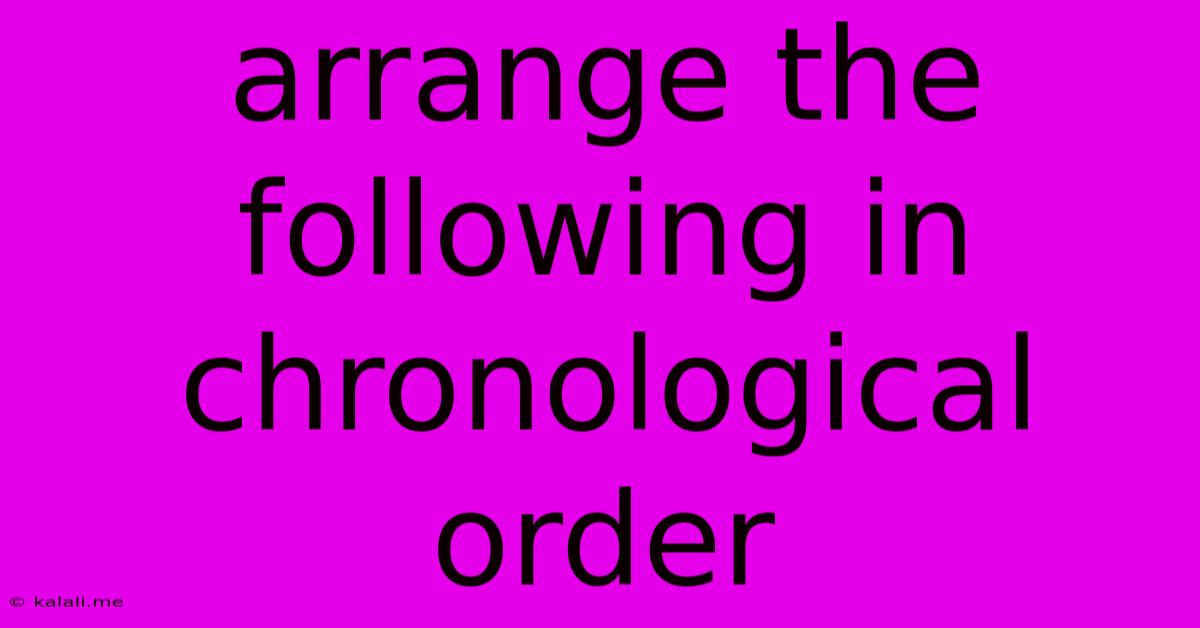Arrange The Following In Chronological Order
Kalali
Jun 12, 2025 · 3 min read

Table of Contents
Mastering the Art of Chronological Order: A Comprehensive Guide
This article will guide you through the process of arranging items in chronological order, a fundamental skill applicable across various aspects of life, from academic essays to personal journaling. We'll explore the concept, offer practical strategies, and delve into common applications. Understanding chronological order is key to clear communication and effective organization.
What is Chronological Order?
Chronological order refers to arranging events or items in the sequence they occurred, from earliest to latest. Think of it as telling a story – you wouldn't start with the climax and then go back to the beginning! This straightforward method ensures clarity and makes it easy for the reader or listener to follow the progression of events. Mastering this skill is crucial for tasks ranging from writing historical accounts to creating project timelines.
Effective Strategies for Arranging Events Chronologically
Arranging items chronologically may seem simple, but certain strategies can enhance accuracy and efficiency, especially when dealing with numerous events or complex timelines.
-
Identify Key Dates & Times: This is the foundational step. For each item, pinpoint the specific date, time, or relevant period. Be precise – using approximate dates like "around 1990" can lead to inaccuracies.
-
Utilize a Timeline: Visual aids are incredibly helpful. Create a timeline using a spreadsheet, whiteboard, or even a simple piece of paper. This allows you to visualize the sequence of events and easily rearrange items as needed.
-
Use a Chronological Chart: Similar to a timeline, a chart helps in visually representing the chronological order. It can include more detailed information than a simple timeline, such as descriptions of events.
-
Consider Contextual Clues: If precise dates aren't available, look for contextual clues within the material. For example, phrases like "before," "after," "following," and "subsequently" can provide valuable hints about the order of events.
-
Cross-Reference Information: If dealing with multiple sources, ensure consistency by cross-referencing information to verify the accuracy of your chronological arrangement.
-
Employ Digital Tools: Various digital tools and software are available to assist with chronological organization. These often allow for easy sorting, rearranging, and the addition of details.
Common Applications of Chronological Order
The application of chronological order is surprisingly widespread. Here are some key examples:
-
Academic Writing: Essays, research papers, and historical analyses often require arranging information chronologically to present a clear and logical narrative.
-
Storytelling: Narrative structure relies heavily on chronological order, guiding the reader through the plot's progression.
-
Project Management: Project timelines and Gantt charts utilize chronological order to track progress and deadlines.
-
Personal Journaling: Keeping a journal requires documenting events in chronological order, preserving the flow of experiences.
-
Legal Documentation: Legal records, such as court transcripts and case files, strictly adhere to chronological order.
-
Resume/CV: While not always strictly chronological, highlighting your professional experience in reverse chronological order is generally preferred.
Conclusion
Arranging items in chronological order is a crucial skill that improves clarity, accuracy, and overall effectiveness. By employing the strategies outlined above and utilizing appropriate tools, you can master this technique and apply it successfully in various contexts. Remember, precision and attention to detail are key to maintaining the integrity of the chronological sequence.
Latest Posts
Latest Posts
-
Which Of The Following Is An Aldehyde
Jun 13, 2025
-
Laughter Is The Best Medicine Speech
Jun 13, 2025
-
List All The Factors Of 32
Jun 13, 2025
-
Which Of The Following Is An Example Of Positive Punishment
Jun 13, 2025
-
What Type Of Consumer Are Humans
Jun 13, 2025
Related Post
Thank you for visiting our website which covers about Arrange The Following In Chronological Order . We hope the information provided has been useful to you. Feel free to contact us if you have any questions or need further assistance. See you next time and don't miss to bookmark.